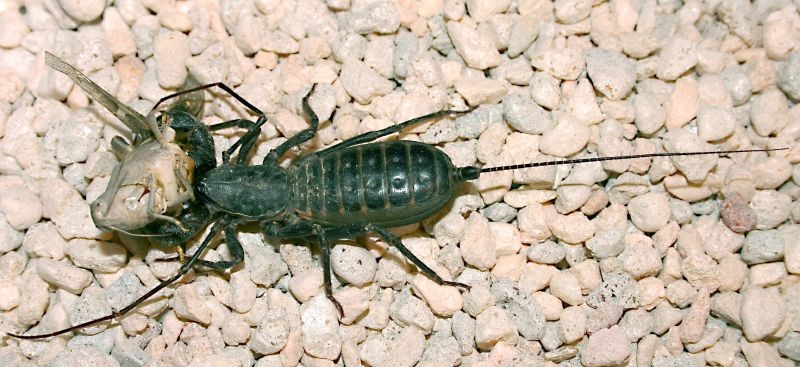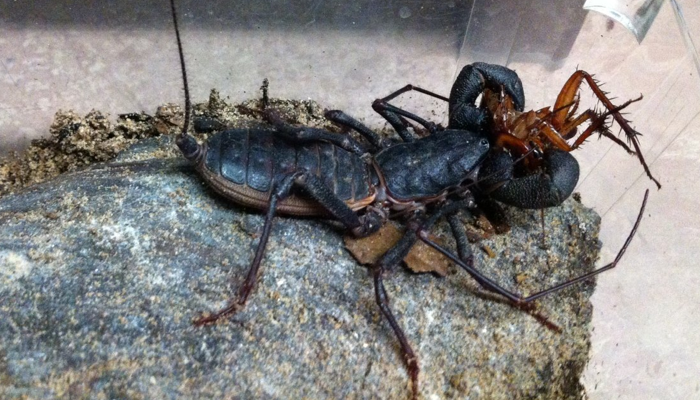Interactions
Mastigoproctus giganteus
is a solitary, nocturnal hunter that
hides in its burrow during the day. It will often hunt near man-made
lights to find insects that flock around them. When it comes to
food, M. giganteus is not a picky eater. Although insects
are its most common prey, it will eat almost any prey as long as it
is within a reasonable size range. Its prey can include beetles,
crickets, grasshoppers, spiders, scorpions, ants and even small
vertebrates (Hogue 1993, Schmidt 2009). To see a video of M.
giganteus eating a cricket, click
HERE. Also take a look at other
students’ pages to learn more about the ant
Eciton hamatum or the grasshopper
Melanoplus differentialis.
Additionally, it has been
discovered that M. giganteus is very adept at overcoming
other organisms’ chemical defenses. Floridobolus penneri,
known as the Florida Scrub Millipede, is a chemically defended
millipede, that when attacked, will release a liquid repellent that
will deter almost any potential predator. Apart from the larva of
the Phengodes laticollis meridian (Phengodid Beetle),
M. giganteus is the only organism known that is able to get
past this defense of the millipede and eat it (Schmidt 2009, Carrel
and Britt 2009).
Studies have
shown that other arachnids such as tarantulas (Aphonopelma
steindachneri), wolf spiders (Hogna carolinensis),
solifuges (Eremobates palpisetulosus), and scorpions (Diplocentrus
bigbendensis) are often in interspecific competition with
M. giganteus. These organisms occupy a similar niche—all being
nocturnal predators, living in the same habitat, and hunting the
same prey (Punzo 2007).
Although
M. giganteus may not have a strong upper hand above these
organisms as a predator, other organisms do not very commonly prey
on it. Many other organisms may attempt to prey on
it, but very few are successful due to M. giganteus's
chemical defenses. Other Arthropods and Vertebrates alike
will retreat from an encounter with M. giganteus, rubbing
their bodies on the ground to relieve the effects of the acetic
acid, giving the Vinegaroon plenty of time to escape (Schmidt 2009).  In an experiment testing the effects of the spray on birds,
solpugids, ants, lizards, grasshopper mice and an armadillo, all of
the organisms would immediately retreat after the spray was
discharged on them. Although spray usually did not do long-term
damage to the predators, it was consistent (except for one trial of
a solpugid) in preventing the predators from harming the Vinegaroon
(Eisner 1961). This defense mechanism is generally so effective that
there is no known predator that is a consistent threat to M.
giganteus (Schmidt 2009).
In an experiment testing the effects of the spray on birds,
solpugids, ants, lizards, grasshopper mice and an armadillo, all of
the organisms would immediately retreat after the spray was
discharged on them. Although spray usually did not do long-term
damage to the predators, it was consistent (except for one trial of
a solpugid) in preventing the predators from harming the Vinegaroon
(Eisner 1961). This defense mechanism is generally so effective that
there is no known predator that is a consistent threat to M.
giganteus (Schmidt 2009).
M.
giganteus has been known to cannibalize on occasion, although
specific scientific cases in nature have not been observed. It has
been hypothesized that the Vinegaroon’s chemical spray would not
protect it against cannibalism, since when defending from other
predators, the spray will usually get on the Vinegaroon’s hardened
armor, and it has no damaging effects to the Vinegaroon (Eisner
1961). This suggests that M. giganteus could be
particularly vulnerable to cannibalistic attacks from other
Vinegaroons, because its usual defense mechanism would most likely
be unsuccessful.
Other than mating, the nurturing of young, and possibly cannibalism,
it seems that M.
giganteus live their lives separate from other members of their
species, living alone in their burrows and hunting alone.
Continue to References
Return to Home